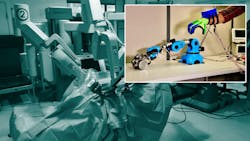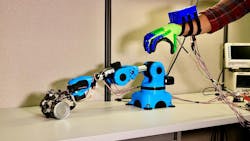Robotic-Assisted Surgery Technique Enhances Tactile Performance
If it’s true the so-called steady hand of the surgeon is overrated, surgeons and patients alike can take solace in robotic systems designed to extend a human’s ability to perform procedures with high accuracy in a minimally invasive manner.
A novel technique developed by researchers at Texas A&M University demonstrates that it is possible to minimize errors when small, perceptible buzzes of electrical currents are delivered to the surgeon’s fingertips. The currents provide an accurate perception of distance to contact and enables users to control their robotic fingers with greater precision as they target fragile surfaces.
At the Fingertips
Telerobotic surgical systems are physical extensions of a surgeon. Robotic end effectors, or grippers resembling human fingers, are the direct interface between the robot and the part that it’s handling. The grippers are designed as an extension of the teleoperators’ fingertips, so they provide enhanced intuitiveness and control accuracy. By controlling robotic fingers with movements of their own fingers, surgeons can perform intricate procedures remotely.
In a video demonstration, Hangue Park, assistant professor in Texas A&M’s Department of Electrical and Computer Engineering, compared the challenge of performing surgery using a telerobotic system to threading a needle while looking at one’s hands reflected in a mirror. While possible, Park acknowledged, it is much harder to accomplish. Surgeons look at a monitor to match their own finger movements with those of the robot. But they are unable to tell the precise distance from their contact point, which can be only roughly ascertained through visual feedback.
“With our design, surgeons will be able to get an intuitive sense of how far their robotic fingers are from contact—information they can then use to touch fragile structures with just the right amount of force,” said Park.
However, visual information is not enough to guide fine finger movements, a critical aspect when the fingers are in close proximity to the brain or other delicate tissue.
“Surgeons can only know how far apart their actual fingers are from each other indirectly—that is, by looking at where their robotic fingers are relative to each other on a monitor,” Park said. “This roundabout view diminishes their sense of how far apart their actual fingers are from each other, which then affects how they control their robotic fingers.”
Park and his team proposed an alternate way to deliver distance information that is also independent of visual feedback. By passing different frequencies of electrical currents on the fingertips, they were able to train users to associate the frequency of the pulsing sensation with distance. Increasing current indicated that they were closing the distance between the fingers and the target area. The researchers compared the performance of users receiving current stimulation along with visual information from the monitors to those who received visual stimulation alone.
In addition, the researchers calibrated their technology to the user’s sensitivity to electrical current frequencies. If a user was sensitive to a wider range of current frequencies, they noted, the distance information was delivered with smaller increments of increasing currents to maximize the accuracy of proximity estimation.
Findings
The research, reported in the journal Scientific Reports, showed that teleoperators receiving electrical pulses were more aware of the proximity to underlying surfaces and could lower their force of contact by about 70%. Overall, they performed much better than the group that was not equipped with the technology.
Proximity information delivered through mild electric pulses was about three times more effective than the visual information alone, noted the researchers. They also found that neither adding the proximity sensation nor visual assistance increased approach time.
Useful Applications
Park said the approach has the potential to significantly increase maneuverability during surgery while minimizing risks of unintended tissue damage. The technique would add little to the existing mental load of surgeons during operative procedures.
“When our technique is ready for use in surgical settings, physicians will be able to intuitively know how far their robotic fingers are from underlying structures, which means that they can keep their active focus on optimizing the surgical outcome of their patients,” Park said.
Aside from surgery, other applications where high control accuracy and delicacy is needed—such as rescue missions or remote maintenance of structures in harsh environments (space and underwater)—could also benefit from the novel telerobotic system.
Learn more about Texas A&M's robotics systems in the clip below (video credit: Dharmesh Patel/Texas A&M Engineering).
About the Author

Rehana Begg
Editor-in-Chief, Machine Design
As Machine Design’s content lead, Rehana Begg is tasked with elevating the voice of the design and multi-disciplinary engineer in the face of digital transformation and engineering innovation. Begg has more than 24 years of editorial experience and has spent the past decade in the trenches of industrial manufacturing, focusing on new technologies, manufacturing innovation and business. Her B2B career has taken her from corporate boardrooms to plant floors and underground mining stopes, covering everything from automation & IIoT, robotics, mechanical design and additive manufacturing to plant operations, maintenance, reliability and continuous improvement. Begg holds an MBA, a Master of Journalism degree, and a BA (Hons.) in Political Science. She is committed to lifelong learning and feeds her passion for innovation in publishing, transparent science and clear communication by attending relevant conferences and seminars/workshops.
Follow Rehana Begg via the following social media handles:
X: @rehanabegg
LinkedIn: @rehanabegg and @MachineDesign

